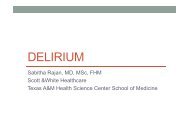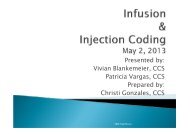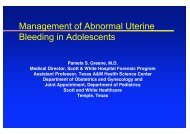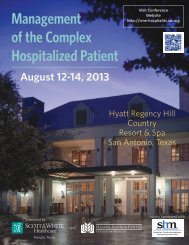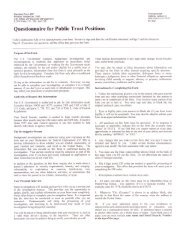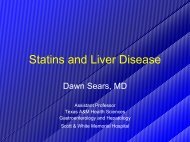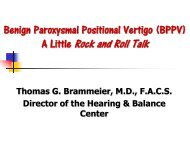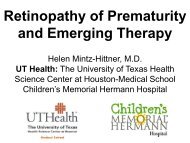DVT Prophylaxis in Orthopaedic Surgery - Healthcare Professionals
DVT Prophylaxis in Orthopaedic Surgery - Healthcare Professionals
DVT Prophylaxis in Orthopaedic Surgery - Healthcare Professionals
Create successful ePaper yourself
Turn your PDF publications into a flip-book with our unique Google optimized e-Paper software.
Robert Probe MDProfessor and ChairmanDepartment of <strong>Orthopaedic</strong>sScott & White Memorial Hospital
Disclosures• Consult<strong>in</strong>g• Stryker <strong>Orthopaedic</strong>s• Speak<strong>in</strong>g• AO• OTA• AAOS• Boards• <strong>Orthopaedic</strong> Trauma Association• Scott & White Board of Trustees• Scott & White Memorial Hospital
Danish Knee RegistryYear of surgery1997-1999 40 (0.82%) 1.0 (reference) 1.0 (reference)2000-2003 131 (1.10%) 1.34 (0.89-2.00) 1.35 (0.90-2.02)2004-2007 270 (1.32%) 1.27 (1.05-1.55) 1.28 (1.05-1.57)Age (yr)10-49 15 (0.86%) 1.0 (reference) 1.0 (reference)50-59 66 (1.09%) 1.26 (0.78-2.05) 1.26 (0.76-2.11)60-69 139 (1.15%) 1.33 (0.88-2.01) 1.29 (0.83-2.01)70-79 153 (1.23%) 1.44 (0.93-2.22) 1.40 (0.85-2.33)≥80 68 (1.41%) 1.65 (1.11-2.43) 1.58 (1.01-2.47)Pederson et al, JBJS-A 2011
Post-op?
6 weeks post-op
Your questions:• Why does this happen <strong>in</strong> trauma?• What is the quantitated risk?• What prophylaxis does this risk justify?• Should we screen?• How long to treat?• What Guidel<strong>in</strong>es are available to direct us?• What do the regulators require?
Virchow’s Triad• Venous stasis• Vascular Injury• Hypercoagulable
FIRST HITTISSUE INJURY
Risk
Low Risk-Age > 40-ISS> 9-transfusion-Lower Extremity Fx-Estrogen therapy-Pregnant-History of <strong>DVT</strong>-Malignancy-Hypercoaguable-CHFHigh Risk-Age > 50-ISS > 16-Femoral l<strong>in</strong>e-AIS >2 (any region)-Pelvis Fx-Femur or Tibia FxVery High Risk-Sp<strong>in</strong>al Cord Injury-Head AIS > 2 and long bone
Risk StratificationCalf Clot Prox Clot Cl<strong>in</strong>ical PE Fatal PE ScoreLow 2 .5 .2 .002 1Moderate 15 3 .5 .3 2High 30 6 3 .7 3-4Highest 60 15 7 2.5 >41 pt 2 pt 3 pt5 pt* M<strong>in</strong>or surgery* Age 41-60* Pregnancy* Varicose ve<strong>in</strong>s* Swell<strong>in</strong>g of legs* Obesity (BMI >25)* Oral contraceptives,* Age over 60 years* Major surgery (>45 m<strong>in</strong>utes)* Conf<strong>in</strong>ed to bed more than 72 hours* Immobiliz<strong>in</strong>g cast* Central venous access* Tourniquet time over 45 m<strong>in</strong>utes* History of <strong>DVT</strong>* Family history* Age over 75 years* CHF, MI, COPD* thrombophilia* Hip, pelvis or leg fracture* Stroke* Multiple trauma* Sp<strong>in</strong>al Cord InjuryChest Guidel<strong>in</strong>es 2004
Other Risk Factors• Obesity• Immobilization• Central Venous Access• Polytrauma• Head Injury• Sp<strong>in</strong>al Cord Injury• Oral Contraceptives• Comorbidities• MI, COPD, CHF• Family History
Oral contraceptive (OCP) use 4Factor V Leiden, heterozygous 6Factor V Leiden, heterozygous + OCP 32Factor V Leiden, homozygous 80Prothromb<strong>in</strong> Gene Mutation, heterozygous 3Prothromb<strong>in</strong> Gene Mutation, heterozygous + OCP 16Prote<strong>in</strong> C deficiency, heterozygous 7Prote<strong>in</strong> S deficiency, heterozygous 6Antithromb<strong>in</strong> deficiency, heterozygous 5Hyperhomocyste<strong>in</strong>emia 3Hyperhomocyste<strong>in</strong>emia +Factor V Leiden 20http://www.med.ill<strong>in</strong>ois.edu/hematology/PtProtS.htm
Composite Risk• Patient predisposition• Risk of procedure or condition• Risk of bleed<strong>in</strong>g
<strong>Prophylaxis</strong>
Risk Stratification
Meta Analysis <strong>in</strong> Pelvic Trauma• Eleven studies• 1760 subjects• Types of <strong>in</strong>terventions:• mechanical compression devices• <strong>in</strong>ferior vena cava filters• low-molecular weight hepar<strong>in</strong>s• ultrasound screen<strong>in</strong>g• magnetic resonance venography screen<strong>in</strong>g.• Most studies were observational designs with m<strong>in</strong>imalcontrol data for comparison.Slobogean, J Ortho Trauma 2009
In the matter of the Matthew Fl<strong>in</strong>ders Taverner66. There was one aspect of the evidence of Mr Sherlock upon which theCommission did have some reservations. Mr Sherlock stated that legaladvice had been obta<strong>in</strong>ed as to the possibility that the egms at the sub-branchcould be transferred to other RSL venues with<strong>in</strong> the City of Monash, and thatsuch possibilities had been explored but had ultimately come to noth<strong>in</strong>gbecause of problems associated with those sub-branches. The Commissionhas been aware of earlier matters <strong>in</strong> which a particular sub-branch has ceasedto operate gam<strong>in</strong>g mach<strong>in</strong>es and those gam<strong>in</strong>g mach<strong>in</strong>es have been removedto another RSL sub-branch which has, thereby, been strengthened as a resultof this exercise. In turn the stronger sub-branch which has received theadditional egms has been able to make a cont<strong>in</strong>u<strong>in</strong>g contribution to the subbranchfrom which the egms have been removed.67. Both <strong>in</strong> the evidence which he gave on his first occasion <strong>in</strong> the witness boxand when he returned to the witness box subsequently, Mr Sherlock wasquestioned about this. Ultimately we are satisfied that appropriate steps havebeen taken to <strong>in</strong>vestigate the possibility that the egms could be transferredwith<strong>in</strong> the RSL network and that for various reasons this cannot be achieved.One other important aspect of his evidence was the fact that <strong>in</strong> this <strong>in</strong>stance(unlike approximately 90 per cent of the sub-branches) the RSL does notown the freehold upon which the sub-branch is erected. That freehold isowned by the local council.68. Mr Sherlock was followed by Mr John Poland whose current role is that ofAct<strong>in</strong>g General Manager and Secretary of the Oakleigh RSL. He listed anumber of the activities which take place at the sub-branch where the mostattractive old build<strong>in</strong>gs are also used for external purposes such asneighbourhood watch and a mother’s club. The ma<strong>in</strong> commercial activity is27
Daltepar<strong>in</strong> <strong>in</strong> all high risk traumapatients• Demographics:• 743 were considered at high risk for <strong>DVT</strong>• mean age of 38.7 years (range 15–89 years)• Mean <strong>in</strong>jury severity score (ISS) of 19.5• Results:• <strong>DVT</strong> was detected <strong>in</strong> 3.9%• PE <strong>in</strong> 0.8%• Wound complications rate was 2.7• There were no exacerbations of head <strong>in</strong>jury follow<strong>in</strong>gdaltepar<strong>in</strong> <strong>in</strong>itiation due to bleed<strong>in</strong>gCothren, World Journal of <strong>Surgery</strong>, 2006
Trauma Studies
Management Guidel<strong>in</strong>eUniversity of Pennsylvania Department of <strong>Orthopaedic</strong> <strong>Surgery</strong>
Patients• 4076 blunt eligible blunt trauma patients identified• 233 (5.7%) had Thromboembolic Event• 213 <strong>DVT</strong>• 31 PE• 20 diagnosed with PE only• 202 diagnosed with <strong>DVT</strong> only• 11 diagnosed with both <strong>DVT</strong> & PE• Power of 0.80 and a two sided alpha of 0.05 to detect adifference of 20% <strong>in</strong> any given parameter between groups• 226 controls selected by pick<strong>in</strong>g every 20th blunt traumapatient <strong>in</strong> the database, then elim<strong>in</strong>at<strong>in</strong>g duplicates with thecase groupUniversity of Pennsylvania Department of <strong>Orthopaedic</strong> <strong>Surgery</strong>
Results• Refractory Risk Factors• Pelvic fractures (3.62x)• Major lower extremity<strong>in</strong>jury (1.83x)• > 3 days mechanicalventilation (8.15x)• Increas<strong>in</strong>g <strong>in</strong>jury severityscore (1.04x)• Sp<strong>in</strong>al cord <strong>in</strong>jury (4.3x)University of Pennsylvania Department of <strong>Orthopaedic</strong> <strong>Surgery</strong>
Revised Management Guidel<strong>in</strong>eSCDSCDorornono<strong>DVT</strong><strong>DVT</strong>prophylaxisprophylaxisNOLMWHRiskRiskfactorsfactors??(A) LMWH++(A) YES SCDSCDHighHighRiskRiskLMWHLMWH++FactorsFactors(B)(B) YESSCDSCDAA..ModerateModerateriskriskfactorsfactors• AgeAge>40*>40*••ISSISS>9*>9*••SurgicalSurgicalprocedureprocedure7272hrs*hrs*••Immobilization*Immobilization*••Pregnancy*Pregnancy*••EstrogenEstrogentherapy*therapy*••HistoryHistoryofof<strong>DVT</strong><strong>DVT</strong>ororPE*PE*••Malignancy*Malignancy*••Hypercoagulability*Hypercoagulability*••ExtensiveExtensivesoftsofttissuetissuetrauma*trauma*••CHFCHF**NO+DuplexDuplexofofLELEwith<strong>in</strong>with<strong>in</strong>72 hr then q5-7 days72 hr then q5-7 daysAfterAfterthatthatB.B.HighHighriskriskfactorsfactors••AgeAge>50*>50*••ISS>16*ISS>16*••FemoralFemorall<strong>in</strong>el<strong>in</strong>eplacedplaced<strong>in</strong><strong>in</strong>bay*bay*••GCSGCS/=3) + long bone fracture• Multiple >/= 3 long bone fractures*• Multiple >/= 3 long bone fractures*• Severe pelvic fracture†• Severe pelvic fracture†• Mechanical ventilation longer than 3 days†• Mechanical ventilation longer than 3 days†• Severe LE fracture + ISS >16†• Severe LE fracture + ISS >16†University of Pennsylvania Department of <strong>Orthopaedic</strong> <strong>Surgery</strong>
Future Directions• The more effectively a chemoprophylactic reduces <strong>DVT</strong><strong>in</strong>cidence, the higher the risk of major bleeds.(Lev<strong>in</strong>e et al, 7th ACCP conference, Chest 2004;12:287S)• EAST guidel<strong>in</strong>es recommend LMWH for patients with certa<strong>in</strong>types of “severe” orthopaedic trauma. Their recommendations,however, are based on <strong>DVT</strong> rates.1. Is LMWH really necessary?Recent guidel<strong>in</strong>es by the AAOS suggest that, for lower risk patients, aspir<strong>in</strong> can be used for<strong>DVT</strong> prophylaxis.2. Would the <strong>in</strong>corporation of Aspir<strong>in</strong> for low risk patients result<strong>in</strong> similar VTE rates?University of Pennsylvania Department of <strong>Orthopaedic</strong> <strong>Surgery</strong>
Hip Fracture Trial:enoxapar<strong>in</strong> vs fondapar<strong>in</strong>ux• 1,711 Randomised hip fracture patients• enoxapar<strong>in</strong> at 40 mg SC qd start<strong>in</strong>g 12h postoperatively,• fondapar<strong>in</strong>ux at 2.5 mg SC qd start<strong>in</strong>g 4h after surgery.• VTE by postoperative day 11• 19.1% enoxapar<strong>in</strong>• 8.3% fondapar<strong>in</strong>ux• respectively (p 0.001).• Proximal <strong>DVT</strong> was also• 4.3% enoxapar<strong>in</strong>• 0.9% fondapar<strong>in</strong>ux• p 0.001).• The improved efficacy with fondapar<strong>in</strong>ux was notaccompanied by more bleed<strong>in</strong>g.Bauer, N Engl J Med 2001
<strong>DVT</strong> Incidence <strong>in</strong> Head InjuryPatients• 939 eligible patients 200-2006• Mechanical prophylaxis only• Weekly duplex screen<strong>in</strong>g• <strong>DVT</strong> rates• Overall 32%• Isolated HI 26%• Associated Injury 35%• Independent Risk Factors• Male gender (p = 0.04)• Age >or=55 (p < 0.001)• ISS >or=15 (p = 0.014)• Subarachnoid hemorrhage (p = 0.006)• Lower extremity <strong>in</strong>jury (p = 0.001)Ekeh, J of Trauma 2010
Incidence of <strong>DVT</strong> with closedtreatment of ankle fractures• 100 patients <strong>in</strong> the absence of anythromboprophylaxis• Doppler duplex ultrasound scan was doneat the time of the removal of the cast.• Results:• Five patients did develop <strong>DVT</strong>• None had cl<strong>in</strong>ical signs suggestive of it• 2 Proximal lesions• “As the <strong>in</strong>cidence of <strong>DVT</strong> after anklefractures is low, we do not recommendrout<strong>in</strong>e thromboprophylaxis.Patil, JBJS-B 2007
Prolonged Daltepar<strong>in</strong> follow<strong>in</strong>gankle fracture• double-bl<strong>in</strong>d, placebo-controlled study, 272 consecutivepatients were randomized to receive either thromboprophylaxiswith Daltepar<strong>in</strong> (n = 136) or placebo (n = 136) for 5 weeks afterankle fracture surgery.• All patients received 1 week of <strong>in</strong>itial treatment with Daltepar<strong>in</strong>before randomization.• <strong>in</strong>cidence of <strong>DVT</strong> was• 21% Daltepar<strong>in</strong> group• 28% <strong>in</strong> the placebo• proximal <strong>DVT</strong>s was• 4% <strong>in</strong> the Daltepar<strong>in</strong> group• 3% <strong>in</strong> the placebo group• “We found no significant difference <strong>in</strong> the <strong>in</strong>cidence of <strong>DVT</strong>between the 2 treatment groups”Lapidus, Acta Orthop 2007
Operatively treated Achillesrupture: Daltepar<strong>in</strong> vs placebo• Design:• 105 randomized patients• 5000 u Daltepar<strong>in</strong> for 6 weeks• Duplex sonography at 3 wk, 6 wk• Outcome• Daltepar<strong>in</strong> group• 16/47 (34%)• Placebo group• 16/44 (36%)Lapidus et al, J Ortho Trauma 2006
Upper Extremity <strong>DVT</strong>• 25 year old follow<strong>in</strong>g cycl<strong>in</strong>gaccident• Tx with figure of 8 dress<strong>in</strong>g• Returns at one week with aswollen armPeivandi, Orthopedics 2011
Venous thromboembolic eventsfollow<strong>in</strong>g shoulder surgery:analysis of a national databasePatients without withReplacement 4,061 0.1 0.2Arthroscopy 63,302 0.01 0.02Fracture 4,696 0.30 3.02Jmeson et al, J Shoulder Elbow Surg 2011
Rivaroxaban for total kneeprophylaxisLassen et al, NEJM 2008
Rivaroxaban vs Enoxapar<strong>in</strong>ThromboembolismOutcome Rivaroaban Enoxapar<strong>in</strong> RiskreductionP valueTotal VTE 9.7% 18.8% 48 0.01Major VTE 1.0% 2.5% 60 0.024Bleed<strong>in</strong>gRivaroxabanEnoxapar<strong>in</strong>Major Bleed<strong>in</strong>g 0.6% 0.5%Cl<strong>in</strong>ically relevant 2.7% 2.4%Wound Complications 2.1% 2.0%Lassen et al, NEJM 2008
Hepar<strong>in</strong> InducedThrombocytopenia• Incidence• LMWH 0.6%• Unfractionated 4.6%
Hepar<strong>in</strong> InducedThrombocytopenia• Immune mediated aggregation of platelets• IgG antibody• B<strong>in</strong>ds to hepar<strong>in</strong> platelet b<strong>in</strong>d<strong>in</strong>g site 4• Creates “white thrombus”• Typically presents between days 4 and 14 of treatment• Diagnosis• Antibody test<strong>in</strong>g has poor specificity• Stress thrombocytosis may mask• Pragmatic: unexpla<strong>in</strong>ed decrease of platelets by 50%
Cost• 5 mg Coumad<strong>in</strong> brand~ $1.50 per pill• 5 mg warfar<strong>in</strong> (generic)~$40 cents/pill• 40 mg q day of Lovenox~$90/day• 30 mg BID of Lovenox~ $135• 5000 units hepar<strong>in</strong>• 10 mg Rivaroxaban4 cents/pill6 cents/pill$17.50/day$13 ea= $26/day$1.70 each; = $5.10/day$6.80/ day
Contra<strong>in</strong>dications for Chemical<strong>Prophylaxis</strong>• Active bleed<strong>in</strong>g or risk of bleed<strong>in</strong>g• Intracranial bleed• Sp<strong>in</strong>e Injury• Abdom<strong>in</strong>al organ <strong>in</strong>jury• Coagulophathy• INR > 1.5• aPTT > 40 seconds• < 50,000 platelets• History of hepar<strong>in</strong> <strong>in</strong>ducedthrombocytopenia• (may use fondapar<strong>in</strong>ux)
Thromboprophylaxis with Sp<strong>in</strong>alInjury• Metaanalysis thru 4/2008• twenty-one studies med <strong>in</strong>clusion criteria• Patients with SCI had relative risk <strong>in</strong>crease of 6.0• Patients managed with VKA had fewer events thancontrols• Treatment <strong>in</strong>itiated with<strong>in</strong> two weeks more effective• LMWH out performed UFHPloumis, JBJS-Am 2009
Indications for Vena Cava Filter• Failure of <strong>Prophylaxis</strong>• Contra<strong>in</strong>dications to prophylaxis <strong>in</strong> high risk patients• High risk of Pulmonary Embolism• Large Cava thrombus
IVC Filter Retrival?• 125 retrievable filters placed over 4 years• Indications (66%)• Head <strong>in</strong>jury• Sp<strong>in</strong>al Cord Injury• 70% of removal candidates did not have their filtersremovedHell<strong>in</strong>g, J of Trauma 2009
Filters <strong>in</strong> <strong>DVT</strong> Treatment• 102 patients with <strong>DVT</strong> follow<strong>in</strong>gpelvic fracture• No <strong>DVT</strong> recurrences• 7% with new swell<strong>in</strong>g• 1% with PTSToro, J Trauma 2008
Screen<strong>in</strong>g
Screen<strong>in</strong>g and PulmonaryEmbolism• From November 1, 1997 though November 31, 1999, ascreen<strong>in</strong>g protocol for deep ve<strong>in</strong> thrombosis wasemployed us<strong>in</strong>g ultrasound and magnetic resonancevenography.• From January 1, 2000 through December 1, 2001, noscreen<strong>in</strong>g was used• 486 patients with fractures of the pelvis or acetabulumscreened• 487 without screen<strong>in</strong>g• PE rates• 2% with screen<strong>in</strong>g• 1.4% without screen<strong>in</strong>gBorer, J Orthop Trauma, 2005
Contrast enhanced CT vs MRV forpelvic thrombosis• 30 patients with pelvic or acetabular fractures andwho met the study criteria were prospectivelyscreened with magnetic resonance venography andcomputed tomography venography• Detection rate:• computed tomography venography <strong>in</strong> two patients(7%)• magnetic resonance venography <strong>in</strong> four patients (13%)• Confirmatory venography• CT false posistive 50%• MRV false positives 100% Stover, J Orthop Trauma 2002
Chest Guidel<strong>in</strong>es• we recommend that every hospitaldevelop a formal strategy thataddresses the prevention of VTE(Grade 1A).• We recommend aga<strong>in</strong>st the use ofaspir<strong>in</strong> alone as thromboprophylaxisfor any patient group (Grade 1A)• We recommend that mechanicalmethods of thromboprophylaxis beused primarily for patients at highbleed<strong>in</strong>g risk (Grade 1A)• Possibly as an adjunct to anticoagulantthromboprophylaxis (Grade 2A).
Chest Guidel<strong>in</strong>es• Hip fracture surgery (HFS), we recommend therout<strong>in</strong>e use of fondapar<strong>in</strong>ux (Grade 1A), LMWH(Grade 1B), a VKA (target INR, 2.5; range, 2.0 to3.0) [Grade 1B], or LDUH (Grade 1B).• For patients undergo<strong>in</strong>g HFS, we recommendaga<strong>in</strong>st the use of aspir<strong>in</strong> alone• For patients undergo<strong>in</strong>g HFS <strong>in</strong> whom surgery islikely to be delayed, we recommend thatthromboprophylaxis with LMWH or LDUH be<strong>in</strong>itiated dur<strong>in</strong>g the time between hospitaladmission and surgery (Grade 1C).
Chest Guidel<strong>in</strong>es• We recommend that all major trauma and allsp<strong>in</strong>al cord <strong>in</strong>jury (SCI) patients receivethromboprophylaxis (Grade 1A).• For asymptomatic patients follow<strong>in</strong>g majororthopedic surgery, we recommend aga<strong>in</strong>st therout<strong>in</strong>e use of DUS screen<strong>in</strong>g before hospitaldischarge (Grade 1A).
Chest Guidel<strong>in</strong>es• For patients undergo<strong>in</strong>g HFS, we recommendthat thromboprophylaxis be extended beyond 10days and up to 35 days after surgery (Grade 1A).• The recommended options for extendedthromboprophylaxis <strong>in</strong> HFS <strong>in</strong>cludefondapar<strong>in</strong>ux (Grade 1A), LMWH (Grade 1C), or aVKA (Grade 1C).
Chest Guidel<strong>in</strong>es• For patients with isolated lower-extremity<strong>in</strong>juries distal to the knee, we suggest thatcl<strong>in</strong>icians not rout<strong>in</strong>ely use thromboprophylaxis(Grade 2A).• For major trauma patients, <strong>in</strong> the absence of amajor contra<strong>in</strong>dication, we recommend thatcl<strong>in</strong>icians use LMWH thromboprophylaxisstart<strong>in</strong>g as soon as it is considered safe to do so(Grade 1A).
Chest Guidel<strong>in</strong>es• No randomized trials have studied the prophylacticuse of IVC filters <strong>in</strong> any patient population, and weare not aware of evidence that their use is of anybenefit when added to the most effectivethromboprophylaxis modality appropriate for thecl<strong>in</strong>ical status.
The counter claim…..• "At this po<strong>in</strong>t, on the basis of an extensive review ofthe literature, we believe that the <strong>in</strong>expensiveprotocol <strong>in</strong>volv<strong>in</strong>g the adm<strong>in</strong>istration of aspir<strong>in</strong>comb<strong>in</strong>ed with <strong>in</strong>traoperative and postoperativeexercises is as effective as the expensive protocol<strong>in</strong>volv<strong>in</strong>g the adm<strong>in</strong>istration of warfar<strong>in</strong> or lowmolecular-weighthepar<strong>in</strong>, and the former isassociated with fewer complications. There are alsostrong data suggest<strong>in</strong>g that chemical prophylaxisfollow<strong>in</strong>g total hip surgery may not be necessary."Sarmiento, JBJS-A 2002
Mortality Risk from PulmonaryEmbolism• 1/3 of thromboembolicdisease identified withsymptoms ofpulmonary embolism• 10% mortality• 10% of hospital deathsLankeit, Cl<strong>in</strong> Chest Med. 2010
AAOS Rationale:PE rather than <strong>DVT</strong>
• The AAOS panel ignored the randomized data demonstrat<strong>in</strong>gthat thromboprophylaxis reduces both <strong>DVT</strong> and PE, and many oftheir recommendations are based on expert op<strong>in</strong>ion and lack ascientific basis. We recommend the ACCP guidel<strong>in</strong>es becausethe methodology is explicit and rigorous and the treatmentrecommendations reflect all of the evidence from therandomized trials.Eikelboom, Chest 2009
NQF Measure• Percentage of patients >18 <strong>in</strong> whom prophylaxis is<strong>in</strong>dicated• Order for:• Low Molecular Weight Hepar<strong>in</strong> (LMWH)• Low-Dose Unfractionated Hepar<strong>in</strong> (LDUH)• adjusted-dose warfar<strong>in</strong>• Fondapar<strong>in</strong>ux• mechanical prophylaxis• Given with<strong>in</strong> 24 hours of the time of surgery.
• —SCIP VTE 1: <strong>Surgery</strong> patients withrecommended venousthromboembolism prophylaxis ordered• —SCIP VTE 2: <strong>Surgery</strong> patients whoreceived appropriate venousthromboembolism prophylaxis with<strong>in</strong> 24hours prior to surgery to 24 hours aftersurgery
Scott & White <strong>Healthcare</strong><strong>DVT</strong> <strong>Prophylaxis</strong>
Scott & White HealthCare<strong>DVT</strong> Order Set
My Practice• Fractures• Pelvis – mid Tibia• Isolated upper extremity• Hip fractures• Sp<strong>in</strong>e• AnkleBID enoxapar<strong>in</strong>Noth<strong>in</strong>gFondapar<strong>in</strong>uxIndividualizedASA if additional riskfactors are present• Filters restricted to those with anticoagulantcontra<strong>in</strong>dications
Thrombolysis• 56 patients prospectively evaluated after lowerextremity thrombolysis for <strong>DVT</strong>• Demographics• Ave age 48• Symptoms less than two weeks• Results• Venographic success 79%• Preserved femoral ve<strong>in</strong> valves 83%• Post thrombotic syndrome 9%Mann<strong>in</strong>en et al, Eur J Radiol 2011
At risk for <strong>in</strong>traoperative bleed<strong>in</strong>g?Risk Factors• Personal or family history ofabnormal bleed<strong>in</strong>g• Liver disease• Significant alcohol use• Malabsorption• Anticoagulant therapyOK to proceed• INR 1.5 or below• PTT with<strong>in</strong> 10 seconds ofcontrol• Platelets > 70,000
Thrombolytics, anticoagulants &antiplatlet drugsWikipedia
Perioperative Management ofantithrombotic therapies• Antiplatelet therapies (ASA & clopidogrel)• Stop 5- 7 days before elective surgery• Exceptions• Drug elut<strong>in</strong>g coronary artery stentsDouketis et al, Chest Guidel<strong>in</strong>es 2008
High Risk Anticoagulated PatientsHigh risk for thrombosis• Mitral mechanical valve• High risk a-fibrillation• Stroke, TIA• Recent VTE (



